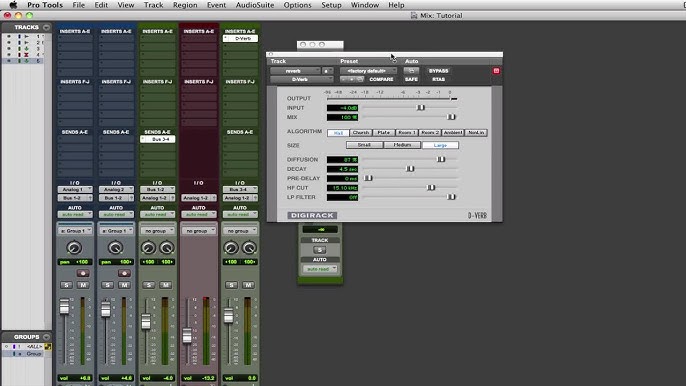Introduction:
Sends and returns, also known as auxiliary sends and returns, serve as essential routing tools in digital audio workstations like Avid Pro Tools, enabling users to apply parallel processing, effects, and spatial enhancements to multiple tracks simultaneously. Understanding how to effectively utilize sends and returns can significantly enhance efficiency, creativity, and sonic depth in your Pro Tools sessions. In this exhaustive guide, we’ll embark on a deep dive into the world of sends and returns in Pro Tools, exploring their core functionalities, advanced techniques, and practical applications for music production, sound design, and audio post-production.
Understanding Sends and Returns in Pro Tools:
Before delving into the specifics of using sends and returns, let’s establish a foundational understanding of their core concepts and components:
- Auxiliary Channels: Sends and returns utilize auxiliary channels, also known as aux tracks or aux buses, to route audio signals to parallel processing chains or effects. Auxiliary channels function as additional paths for processing audio signals independently from the main signal path, allowing users to apply effects or enhancements without affecting the original audio.
- Send Controls: Send controls on individual tracks allow users to send a portion of the audio signal from each track to one or more auxiliary channels. Users can adjust the send level to control the amount of signal sent to the auxiliary channels, determining the intensity of the effect or processing applied.
- Return Controls: Return controls on auxiliary channels allow users to blend the processed audio signal back into the mix at the desired level. Users can adjust the return level to control the balance between the dry (original) and wet (processed) signals, ensuring the desired amount of effect or enhancement.
- Parallel Processing: Sends and returns facilitate parallel processing, where audio signals are processed independently and blended back into the mix alongside the original signal. This technique allows users to apply effects, such as reverb, delay, or modulation, without altering the original audio, enhancing depth, dimensionality, and creativity in the mix.
Getting Started with Sends and Returns:
Now that we have a foundational understanding of sends and returns in Pro Tools, let’s explore the step-by-step process of using sends and returns in your session:
- Creating Auxiliary Channels:
- Create auxiliary channels in Pro Tools to serve as return paths for processed audio signals. Add new auxiliary tracks to your session and assign inputs and outputs as needed, naming each auxiliary channel descriptively to reflect its purpose or function.
- Setting Up Sends:
- Set up sends on individual tracks to route audio signals to auxiliary channels. Access the send controls on each track and assign the desired auxiliary channel as the send destination, adjusting the send level to control the amount of signal sent to the auxiliary channel.
- Applying Effects or Processing:
- Insert effects or processing plugins on the auxiliary channels to apply parallel processing to the audio signals. Experiment with different effects, such as reverb, delay, modulation, EQ, or compression, to enhance depth, spatial characteristics, and sonic texture in your mix.
- Blending Returns:
- Blend the processed audio signals back into the mix using the return controls on the auxiliary channels. Adjust the return level to control the balance between the dry (original) and wet (processed) signals, ensuring the desired amount of effect or enhancement in the mix.
Advanced Sends and Returns Techniques:
Once you’re comfortable with the basics, consider exploring some advanced sends and returns techniques to enhance your workflow and achieve professional-grade results:
- Parallel Compression:
- Utilize sends and returns to apply parallel compression to individual tracks or groups of tracks. Route audio signals to an auxiliary channel with a compressor inserted, then blend the compressed signal back into the mix to add punch, impact, and cohesion without sacrificing dynamics.
- Creative Effects Chains:
- Create complex effects chains using multiple auxiliary channels and routing configurations. Experiment with serial or parallel processing chains, combining different effects and processing plugins to create unique textures, atmospheres, and sonic landscapes in your mix.
- Spatial Processing:
- Use sends and returns to apply spatial processing effects, such as reverb and delay, to create depth, dimensionality, and movement in your mix. Experiment with different reverb algorithms, delay times, and modulation settings to enhance realism and immersion in your audio productions.
Practical Applications of Sends and Returns:
Sends and returns in Pro Tools find wide-ranging applications across various fields of audio production, including:
- Music Production: Use sends and returns to apply effects, such as reverb, delay, and modulation, to individual tracks or groups of tracks in music production projects. Enhance depth, dimensionality, and creativity in your mixes, adding polish and professionalism to your recordings.
- Sound Design: Explore sends and returns to create immersive soundscapes, textures, and atmospheres for film, television, and multimedia projects. Apply spatial processing effects to sound effects, dialogue, and music, enhancing realism and immersion in your audio productions.
- Audio Post-Production: Utilize sends and returns for dialogue editing, sound effects processing, and mixing in audio post-production workflows for film, television, and video games. Apply effects and processing to enhance clarity, spatial characteristics, and impact in your audio mixes.
Conclusion:
Sends and returns in Pro Tools represent powerful tools for enhancing creativity, workflow, and sonic depth in audio production. By mastering the art of using sends and returns, users can achieve greater flexibility, control, and professionalism in their Pro Tools sessions.
Whether you’re applying effects, processing, or spatial enhancements, Pro Tools provides the tools, features, and flexibility you need to harness the full potential of sends and returns in your audio productions. So, dive in, experiment, and let the boundless possibilities of sends and returns in Pro Tools elevate your creative journey to new heights.
